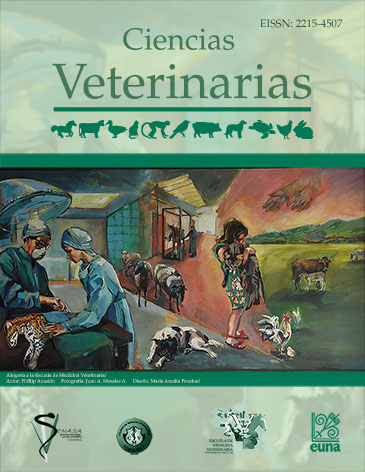Cryptococcus neoformans in the nasal cavity of a cat in Costa Rica. A case report
DOI:
https://doi.org/10.15359/rcv.36-2.3Keywords:
cryptococcosis, Cryptococcus neoformans, cat, laboratory diagnosis, nasal mycosisAbstract
Feline cryptococosis is caused by the encapsulated yeasts of the complex Cryptococcus neoformans and Cryptococcus gattii. This is the most frequent mycosis in cats that could be either asymptomatic or with respiratory and neurologic signs. No cases have been reported in Costa Rica. A crossbreed, shorthair, male cat of 4 years old with refractory 6 months sneezing, unilateral nasal discharge, was examined. A biopsy of nasal mucosal tissue and a nasal lavage were performed in order to carry out cytological and mycological analysis. A pyogranulomatous process with several encapsulated yeasts were observed in the cytology. Encapsulated yeasts were also observed in the direct microscopic examination using KOH, Indian Ink and in the smear stained with Giemsa. Cryptococcus sp. was isolated from tissue cultures and was confirmed as C. neoformans by API 20C AUX (Biomérieux®). The cat was treated during 9 months with satisfactory clinical results. Cryptococcosis must be considered in the differential diagnosis of feline patients with chronic and colorless unilateral nasal discharge. Confirmation must be performed by laboratory tests in order to set up the appropriate treatment.
References
Cabañes, F. J. 2008. Micosis y zoonosis: Cryptococcus spp. Rev. Iberoam. Micol. 25: S1-3. Doi:10.1016/S1130-1406(08)70018-4
Castellá, G., Abarca, M. L. & Cabañes, J. 2008. Criptococosis y animales de compañía. Rev. Iberoam. Micol. 25: S19-24. Doi: 10.1016/S1130-1406(08)70021-4
Duncan, C., Stephen, C. & Campbell, J. 2006. Clinical characteristics and predictors of mortality for Cryptococcus gattii infection in dogs and cats of Southwestern British Columbia. Canadian Vet. J. 47(10): 993-98.
Fooshee-Grace, S. 2010. Cryptococcosis. In: Norsworthy, G. D., Fooshee-Grace, S., Crystal, M. A. & Tilley, L. P. (Ed.). The feline patient, 4th Edition. Wiley-Blackwell, Iowa. p. 97-99.
Hawkins, E. C. 2010. Respiratory system disorders: clinical manifestation of nasal disease. In: Nelson, R. W. & Couto, C. G. (Ed.). Small animal internal medicine. Elsevier, Missouri. p. 217-23.
Johnson, L. R. 2010. Nasal disorders. In: Clinical canine and feline respiratory medicine. Wiley-Blackwell, Iowa. p. 65-68.
Klein, K. R., Hall, L., Deml, S. M., Rysavy, J. M., Wohlfiel, S. L. & Wengenack, N. L. 2009. Identification of Cryptococcus gattii by use of L-canavanine glycine bromothymol blue medium and DNA sequencing. J. Clin. Microbiol. 47(11): 3669-72. Doi: 10.1128/JCM.01072-09
López, A. 2012. Respiratory system, mediastinum and pleurae. In: Zachary, J. & MacGavin, M. D. (Ed.). Pathologic basis of veterinary disease, 5th Edition. Elsevier-Mosby, Missouri. p. 529-30.
Malik, R., Wigney, D. I., Muir, D. B. & Love, D. N. 1997. Asymptomatic carriage of Cryptococcus neoformans in the nasal cavity of dogs and cats. J. Med. Vet. Mycol. 35: 27-31.
Springer, D. J. & Chaturvedi, V. 2010. Projecting global occurrence of Cryptococcus gattii. Emerg. Infect. Dis. 16(1): 14-20. Doi: 10.3201/eid1601.090369
Stokes, J. 2012. Infectious diseases. Fungal and rickettsial diseases. In: Little, S. (Ed.). The Cat: Clinical Medicine and Management. Elsevier Saunders, Missouri. p.1016 -19.
Sykes, J. E. & Malik, R. 2012. Cryptococcosis. In: Greene, C. E. (Ed.). Infectious diseases of the dog and cat, 4th Edition. Elsevier-Saunders, Missouri. p. 621-34.
Downloads
Published
How to Cite
Issue
Section
License
Licensing of articles
All articles will be published under a license:

Licencia Creative Commons Atribución-NoComercial-SinDerivadas 3.0 Costa Rica.
Access to this journal is free of charge, only the article and the journal must be cited in full.
Intellectual property rights belong to the author. Once the article has been accepted for publication, the author assigns the reproduction rights to the Journal.
Ciencias Veterinarias Journal authorizes the printing of articles and photocopies for personal use. Also, the use for educational purposes is encouraged. Especially: institutions may create links to specific articles found in the journal's server in order to make up course packages, seminars or as instructional material.
The author may place a copy of the final version on his or her server, although it is recommended that a link be maintained to the journal's server where the original article is located.
Intellectual property violations are the responsibility of the author. The company or institution that provides access to the contents, either because it acts only as a transmitter of information (for example, Internet access providers) or because it offers public server services, is not responsible.







